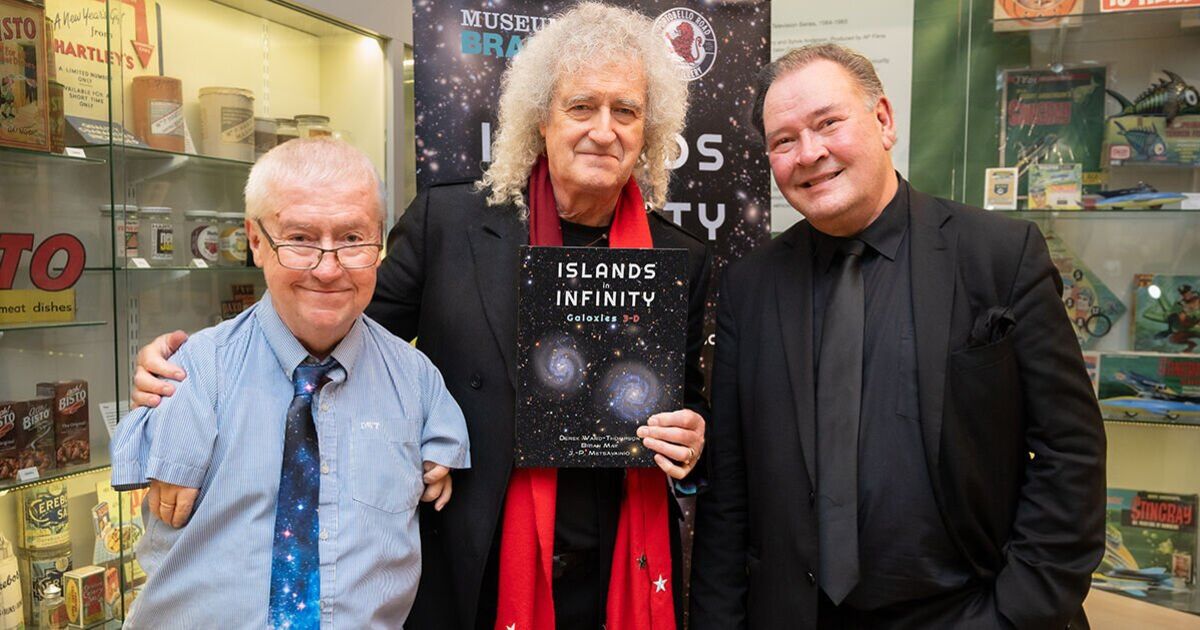Aside from being lead guitarist for one of the most successful rock bands in the world, Sir Brian May is a man of many other interests and talents.
Two areas that are particularly close to his heart are astrophysics (he has a doctorate in the scientific field) and stereoscopy, a historic method of viewing images in 3-D by using pairs of images to simulate depth.
Now the 78-year-old legend has combined the two for a new book called Islands in Infinity: Galaxies 3-D, which is the first publication ever to view galaxies in a stunning three-dimensional stereoscopic form.
Daily Express attended the book launch at Notting Hill’s Museum of Brands, slurping down space-themed cocktails from the Portobello Road Distillery as Sir Brian and his co-authors – Professor Derek Thompson, a leading expert on galaxies, and astrophotographer J-P Metsavainio — guided us (wearing 3-D glasses) through mesmerising images of the cosmos.
We also sat down with Sir Brian for an exclusive interview to chat about the cosmic new book.
Islands in Infinity: Galaxies 3-D looks wonderfully educational and accessible
Yes, the whole thing about our books and the London Stereoscopic Company is that we don’t want to talk above people. We want everyone to really understand what’s going on. So I always go in as chief editor. I go through everything with a fine-tooth comb and make sure that everything is understandable in plain English to anyone who’s interested in the subject. So yeah, these are definitely populist books without any apologies, and there’s no equations in them. I mean, I kind of like equations, but they can be off-putting for people coming into it. And so everything is explained with lots of pictures, diagrams and in this case, with stereoscopic photographs, which are amazing. Nobody has done this before.
How many of the galaxy pictures involved are brand new ones, and how ancient are we talking?
Mainly, they’re brand new because J-P Metsavainio, who is our astrophotographer, takes them himself. Sometimes with his own bare hands, sometimes remotely with robotic telescopes. But most of these, I’d say about 90% of them, he’s done from scratch. It’s not like taking a Hubble picture and working on it. He does it himself. He’s an extraordinary guy. He’s a Finn and he spends his whole life with this passionate belief that he can portray the universe in stereo. So he’s right up my street.
One picture is from the Rubin telescope in Chile, which sees further into the universe than almost anything. So we’re looking back billions of years at these beautiful galaxies. It’s extraordinary. I mean, to me, it boggles my mind. I still can’t quite compute it. Those billions of stars probably all have planets going around them. And then there’s billions of them on top of that. But the thing is, I think doing this in stereo, you get much more of an instinctive idea, of what it feels like if you’re out there with eyes many light years apart, thinking what would the universe look like? It would look like what you see in this book; the observable universe. That’s what humanity is allowed to see. Nobody knows what’s beyond that. Nobody knows how big it is, but this is a pretty good survey of what we can see.
What are the origins of your fascination with astrophysics?
For me it goes back to Patrick Moore. I used to beg my parents to be allowed to stay up and watch The Sky at Night every week, and I was just enthralled. I was thrilled by the pictures that he could show of what we could see in the night sky. I used to rush out and try and see myself. I got myself a little telescope, which actually me and my dad made same as we made my guitar.
And I find it beautiful and inspiring. And there is a spiritual side to it, I suppose. Because certainly in the days when I was going through the worst of my depression, they asked me what my spirituality was, and I said, ‘I don’t really know.’ And then I started to talk about the stars and the fact that Orion comes up every winter. They, to me, they’re kind of like the brave stars, because they’re eternal, and I feel like I can kind of anchor myself to them. And they said that’s spirituality. I’ve known that the stars kind of anchor me into my version of stability in the universe.
Islands in Infinity: Galaxies 3-D, published by the London Stereoscopic Company, is available now from here.
By George Simpson
Source link



Leave a Reply